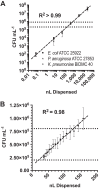The Inoculum Effect in the Era of Multidrug Resistance: Minor Differences in Inoculum Have Dramatic Effect on MIC Determination
- PMID: 29784837
- PMCID: PMC6105823
- DOI: 10.1128/AAC.00433-18
The Inoculum Effect in the Era of Multidrug Resistance: Minor Differences in Inoculum Have Dramatic Effect on MIC Determination
Abstract
The observed MIC may depend on the number of bacteria initially inoculated into the assay. This phenomenon is termed the inoculum effect (IE) and is often most pronounced for β-lactams in strains expressing β-lactamase enzymes. The Clinical and Laboratory Standards Institute (CLSI)-recommended inoculum is 5 × 105 CFU ml-1 with an acceptable range of 2 × 105 to 8 × 105 CFU ml-1 IE testing is typically performed using an inoculum 100-fold greater than the CLSI-recommended inoculum. Therefore, it remains unknown whether the IE influences MICs during testing performed according to CLSI guidelines. Here, we utilized inkjet printing technology to test the IE on cefepime, meropenem, and ceftazidime-avibactam. First, we determined that the inkjet dispense volume correlated well with the number of bacteria delivered to microwells in 2-fold (R2 = 0.99) or 1.1-fold (R2 = 0.98) serial dilutions. We then quantified the IE by dispensing orthogonal titrations of bacterial cells and antibiotics. For cefepime-resistant and susceptible dose-dependent strains, a 2-fold increase in inoculum resulted in a 1.6 log2-fold increase in MIC. For carbapenemase-producing strains, each 2-fold reduction in inoculum resulted in a 1.26 log2-fold reduction in meropenem MIC. At the lower end of the CLSI-allowable inoculum range, minor error rates of 34.8% were observed for meropenem when testing a resistant-strain set. Ceftazidime-avibactam was not subject to an appreciable IE. Our results suggest that IE is sufficiently pronounced for meropenem and cefepime in multidrug-resistant Gram-negative pathogens to affect categorical interpretations during standard laboratory testing.
Keywords: CLSI; MIC; antimicrobial susceptibility testing; broth microdilution; carbapenem-resistant Enterobacteriaceae; extended-spectrum β-lactamase producers; inkjet printing; inoculum; inoculum effect.
Copyright © 2018 American Society for Microbiology.
Figures


Similar articles
-
In vitro comparative activity of the new beta-lactamase inhibitor taniborbactam with cefepime or meropenem against Klebsiella pneumoniae and cefepime against Pseudomonas aeruginosa metallo-beta-lactamase-producing clinical isolates.Int J Antimicrob Agents. 2021 Nov;58(5):106440. doi: 10.1016/j.ijantimicag.2021.106440. Epub 2021 Sep 20. Int J Antimicrob Agents. 2021. PMID: 34551356
-
In vitro activity of avibactam (NXL104) in combination with β-lactams against Gram-negative bacteria, including OXA-48 β-lactamase-producing Klebsiella pneumoniae.Int J Antimicrob Agents. 2012 Jan;39(1):86-9. doi: 10.1016/j.ijantimicag.2011.09.012. Epub 2011 Oct 29. Int J Antimicrob Agents. 2012. PMID: 22041508
-
In Vitro Activity of Ceftazidime-Avibactam against Clinical Isolates of Enterobacteriaceae and Pseudomonas aeruginosa Collected in Asia-Pacific Countries: Results from the INFORM Global Surveillance Program, 2012 to 2015.Antimicrob Agents Chemother. 2018 Jun 26;62(7):e02569-17. doi: 10.1128/AAC.02569-17. Print 2018 Jul. Antimicrob Agents Chemother. 2018. PMID: 29760124 Free PMC article.
-
Cefiderocol: A Siderophore Cephalosporin with Activity Against Carbapenem-Resistant and Multidrug-Resistant Gram-Negative Bacilli.Drugs. 2019 Feb;79(3):271-289. doi: 10.1007/s40265-019-1055-2. Drugs. 2019. PMID: 30712199 Review.
-
The β-Lactams Strike Back: Ceftazidime-Avibactam.Pharmacotherapy. 2015 Aug;35(8):755-70. doi: 10.1002/phar.1622. Pharmacotherapy. 2015. PMID: 26289307 Free PMC article. Review.
Cited by
-
Rapid molecular phenotypic antimicrobial susceptibility test for Neisseria gonorrhoeae based on propidium monoazide viability PCR.bioRxiv [Preprint]. 2023 Mar 1:2023.03.01.530513. doi: 10.1101/2023.03.01.530513. bioRxiv. 2023. Update in: ACS Infect Dis. 2023 May 12;9(5):1160-1167. doi: 10.1021/acsinfecdis.3c00096. PMID: 36909582 Free PMC article. Updated. Preprint.
-
PKPD modeling of the inoculum effect of combined ceftazidime/avibactam and colistin against KPC-3 Klebsiella pneumoniae isolate.Antimicrob Agents Chemother. 2025 May 7;69(5):e0179724. doi: 10.1128/aac.01797-24. Epub 2025 Apr 14. Antimicrob Agents Chemother. 2025. PMID: 40227072 Free PMC article.
-
Enzybiotics LYSSTAPH-S and LYSDERM-S as Potential Therapeutic Agents for Chronic MRSA Wound Infections.Antibiotics (Basel). 2020 Aug 15;9(8):519. doi: 10.3390/antibiotics9080519. Antibiotics (Basel). 2020. PMID: 32824115 Free PMC article.
-
MtlD as a therapeutic target for intestinal and systemic bacterial infections.J Bacteriol. 2025 Jan 31;207(1):e0048024. doi: 10.1128/jb.00480-24. Epub 2024 Dec 27. J Bacteriol. 2025. PMID: 39727397 Free PMC article.
-
Transiently silent acquired antimicrobial resistance: an emerging challenge in susceptibility testing.J Antimicrob Chemother. 2023 Mar 2;78(3):586-598. doi: 10.1093/jac/dkad024. J Antimicrob Chemother. 2023. PMID: 36719135 Free PMC article. Review.
References
-
- Harada Y, Morinaga Y, Kaku N, Nakamura S, Uno N, Hasegawa H, Izumikawa K, Kohno S, Yanagihara K. 2014. In vitro and in vivo activities of piperacillin-tazobactam and meropenem at different inoculum sizes of ESBL-producing Klebsiella pneumoniae. Clin Microbiol Infect 20:O831–O839. doi:10.1111/1469-0691.12677. - DOI - PubMed
-
- Benson CA, Beaudette F, Trenholm G. 1987. Comparative in-vitro activity of LY146032 a new peptolide, with vancomycin and eight other agents against Gram-positive organisms. J Antimicrob Chemother 20:191–196. - PubMed
Publication types
MeSH terms
Substances
Grants and funding
LinkOut - more resources
Full Text Sources
Other Literature Sources
Medical

